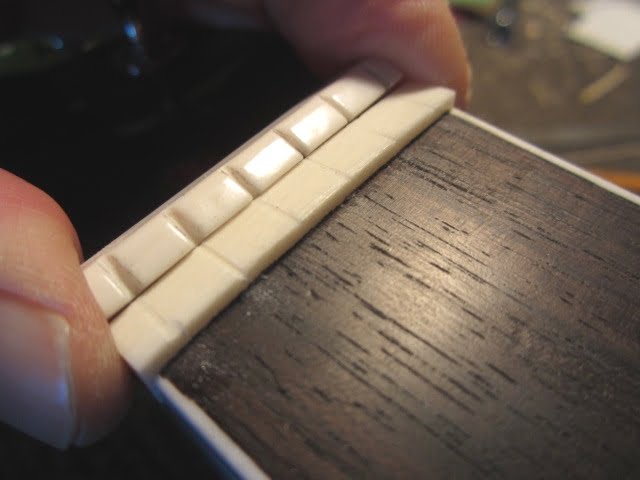A pretty common repair job is to replace a broken, worn, or improperly cut nut on a guitar and bass, although many people are under the false impression that it’s a simple replacement and will just easily “pop into place.” In just about every instance, it won’t. Sure, you can “MacGyver” it, or otherwise manhandle it into place. But, what about the nut slot depth or the edges hanging off the neck? Something is going to seem off.
A new nut quite often needs to be made for the particular instrument out of a slab of raw material. It takes time, and craft to ensure all the dimensions are correct, as well as the string-to-string spacing and slot depth. The nut should fit in the nut slot (or shelf) perfectly square and uniform to transfer the strings energy efficiently.
Of course, there are drop-in nut blanks available from companies such as GraphTech, but these often still require final sizing/shaping, string placement, or slot depth. All these final adjustments will require that the instrument is appropriately setup FIRST. Filing nut slot depth before setting up the guitar is a big mistake. Why? The slot depth cannot be properly measured unless the string height is correctly set with neck relief (bow), saddle height, and neck angle (if applicable). If these attributes are not taken into account, the slot depths can be overcut, resulting in poor performance, buzz, and in some cases, dead open strings.
Is it worth it?
Yes! The nut is one of the most crucial areas on your instrument for your tone and tuning stability! The nut (and bridge) transfers the vibration of the strings to the wood, and the density of the nut will impact the sound. There can be a very drastic change in tone with an upgraded nut. And when done correctly, performance should be enhanced as well.
Materials
Here’s a following breakdown of common nut materials and their tonal attributes.
Bone
Bone is the nut material of choice for many luthiers, guitar technicians, and tone buffs. When cut correctly, they perform exceptional well, are durable, and produce articulate tone and great sustain. White bone is bleached for appearance but is slightly softer and less dense than unbleached bone. For the best tone and vintage vibe, grab the unbleached.
Fossil Ivory
If you’ve got the bucks, fossil ivory is said to be the premium material for providing the best tone. Fossil ivory comes from animals that died naturally millions of years ago and has been found throughout the planet.
Brass/Metal
Brass was very popular during the seventies and eighties, although some companies still use it today. As you would expect, it is highly durable and produces a distinct tone.
Composites
Composite plastics are materials like TUSQ, Corian or Micarta. These materials are designed to mimic bone but with the added benefit of being more consistent in density. Bone can have natural irregularities affected density and, therefore, can be slightly different from piece to piece. Fender, Martin, Taylor, and Gibson guitars are just a small example of high-end guitar makers who use composite nuts.
Graphite
Another option is graphite, which is very popular because of companies such as Graphtech. The advantage to graphite is that it’s “self-lubricating”. This means low friction, which in turn equals better performance, especially with tremolos.
Plastic
Plastic nuts are the most common nut offered. Just about every lower-end guitar will have them. They are not durable, and they do not offer any tonal benefit (unless you like the sound of them). But they are the cheapest.
DIY
Do you want to learn how to replace the nut on your guitar yourself? I’ll be adding a series of articles soon on Nut repair that will show you nut replacement and nut filing, step-by-step. What are you guys most curious about? Post your questions below.








